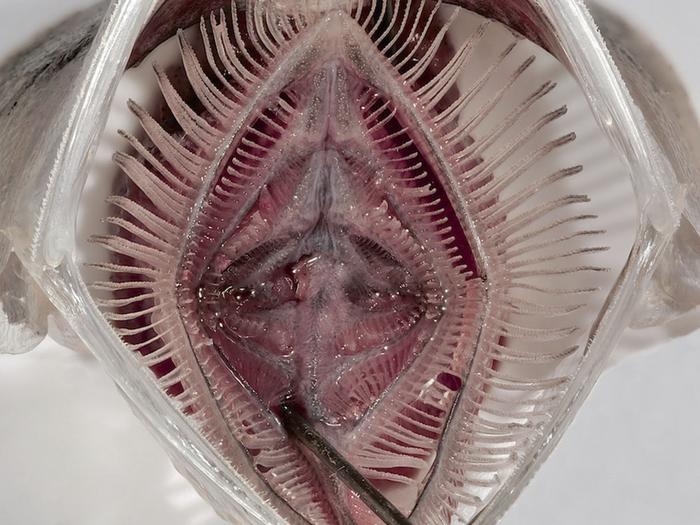The newly approved project “Development of a biomimetic prototype to reduce microplastics emissions” (SuspensionFlow) has the aim of developing an innovative prototype for a microplastic filter for washing machines and other applications. “In the SuspensionFlow project, we want to develop a technology inspired by a mechanism found in some fish to filter out microplastic from wastewater, especially microplastic found in the drainage water of washing machines,” says Prof. Dr. Alexander Blanke of the University of Bonn. Microplastics can be released into the air, soil and water, where they can have a negative impact on organisms and the environment. Washing machines account for a significant proportion of these microplastic emissions because they cannot filter them out. Even wastewater treatment plants can only remove them to a limited extent.
The SuspensionFlow project could help to reduce microplastic emissions from washing machines by at least 80 percent. The project is based around a bionic filter module that mimics biological structures, forms and processes. Suspension feeders, which include filter feeding fish, separate food particles from the surrounding water and serve as a role model for this research. “Filter feeding fish have a so-called ‘gill raker system’ in their mouths that is specially adapted to filtering plankton,” explains Dr. Leandra Hamann, who carried out research on the fish as part of her doctoral studies. “We initially measured and scanned the gill arches and rakes in five different species and used this information to develop 3D models of them. In the next step, we used a 3D printer to produce simplified versions with various geometries and tested them on a test stand. We were able to show that the filtration principle could also work in a technical context.” The aim is now to use and adapt this type of filtration technology to develop a new filter for reducing microplastic emissions.
“Furthermore, we also plan to use sustainable materials in the design of this non-clogging filter and thus achieve a positive environmental footprint,” explains Prof. Blanke. “Our microplastic filter could be installed in every household washing machine. Moreover, this new technology could be integrated into production chains quickly and inexpensively.”
Basic research on filtration mechanisms
Prof. Blanke was awarded a coveted Starting Grant of 1.5 million euros from the ERC in 2017. He will now be able to build on this work with the Proof of Concept Grant. “As part of the ERC Starting Grant ‘Mech-Evo-Insect’, we initially created an overview of how insects feed and compared it with other animals. This led us to examine fish and their gills in more detail and is ultimately how we developed the idea for a bionic filter,” he explains.
Another innovation in the field of bionics at the University of Bonn
“We are delighted that the University of Bonn has once again been awarded an ERC Proof of Concept Grant,” says Sandra Speer, Head of the Transfer Center enaCom. The University of Bonn was already awarded three coveted grants (https://www.uni-bonn.de/de/neues/064-2023 and https://www.uni-bonn.de/de/neues/014-2024). enaCom accompanies applicants through the ERC process in cooperation with the research funding service at the university. The SuspensionFlow project from Prof. Blanke is a good example of bionics, demonstrating how solutions found in nature can be transferred to practical applications. The University of Bonn has a long history of developing successful innovations, especially in this field of research, such as the discovery of the renowned lotus effect or the recent spin-off ClingtechBionics.
The ERC Proof of Concept Grants, which are endowed with 150,000 euros, are highly competitive and support early-stage research that has the potential to make a commercial or societal impact. They are exclusively aimed at researchers who already hold an ERC grant and help them further develop their pioneering research towards real-world applications. The funding aims to help plug the gap between research results and the early phases of marketing subsequent applications.

Credit: Leandra Hamann / University of Bonn
The newly approved project “Development of a biomimetic prototype to reduce microplastics emissions” (SuspensionFlow) has the aim of developing an innovative prototype for a microplastic filter for washing machines and other applications. “In the SuspensionFlow project, we want to develop a technology inspired by a mechanism found in some fish to filter out microplastic from wastewater, especially microplastic found in the drainage water of washing machines,” says Prof. Dr. Alexander Blanke of the University of Bonn. Microplastics can be released into the air, soil and water, where they can have a negative impact on organisms and the environment. Washing machines account for a significant proportion of these microplastic emissions because they cannot filter them out. Even wastewater treatment plants can only remove them to a limited extent.
The SuspensionFlow project could help to reduce microplastic emissions from washing machines by at least 80 percent. The project is based around a bionic filter module that mimics biological structures, forms and processes. Suspension feeders, which include filter feeding fish, separate food particles from the surrounding water and serve as a role model for this research. “Filter feeding fish have a so-called ‘gill raker system’ in their mouths that is specially adapted to filtering plankton,” explains Dr. Leandra Hamann, who carried out research on the fish as part of her doctoral studies. “We initially measured and scanned the gill arches and rakes in five different species and used this information to develop 3D models of them. In the next step, we used a 3D printer to produce simplified versions with various geometries and tested them on a test stand. We were able to show that the filtration principle could also work in a technical context.” The aim is now to use and adapt this type of filtration technology to develop a new filter for reducing microplastic emissions.
“Furthermore, we also plan to use sustainable materials in the design of this non-clogging filter and thus achieve a positive environmental footprint,” explains Prof. Blanke. “Our microplastic filter could be installed in every household washing machine. Moreover, this new technology could be integrated into production chains quickly and inexpensively.”
Basic research on filtration mechanisms
Prof. Blanke was awarded a coveted Starting Grant of 1.5 million euros from the ERC in 2017. He will now be able to build on this work with the Proof of Concept Grant. “As part of the ERC Starting Grant ‘Mech-Evo-Insect’, we initially created an overview of how insects feed and compared it with other animals. This led us to examine fish and their gills in more detail and is ultimately how we developed the idea for a bionic filter,” he explains.
Another innovation in the field of bionics at the University of Bonn
“We are delighted that the University of Bonn has once again been awarded an ERC Proof of Concept Grant,” says Sandra Speer, Head of the Transfer Center enaCom. The University of Bonn was already awarded three coveted grants (https://www.uni-bonn.de/de/neues/064-2023 and https://www.uni-bonn.de/de/neues/014-2024). enaCom accompanies applicants through the ERC process in cooperation with the research funding service at the university. The SuspensionFlow project from Prof. Blanke is a good example of bionics, demonstrating how solutions found in nature can be transferred to practical applications. The University of Bonn has a long history of developing successful innovations, especially in this field of research, such as the discovery of the renowned lotus effect or the recent spin-off ClingtechBionics.
The ERC Proof of Concept Grants, which are endowed with 150,000 euros, are highly competitive and support early-stage research that has the potential to make a commercial or societal impact. They are exclusively aimed at researchers who already hold an ERC grant and help them further develop their pioneering research towards real-world applications. The funding aims to help plug the gap between research results and the early phases of marketing subsequent applications.




